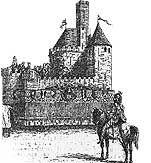| |
 |
| As a site for entertainment, the monument had a life-size, three dimensional image. But, at the same time there was a reverse trend, as artists began to represent it in reduced form. At the beginning of the XXth Century a plasterer, Louis Lacombe, nicknamed Cigalet, who had been born in one of the houses in the lists, displayed a 1cm. by 1m. walnut model to the tourists. This model was the result of more than thirty years work. It was an almost exact copy of Viollet-le-Duc's work and became in itself a historical monument. Today, it is kept in the Count's Castle. |
| | Louis Lacombe was certainly followed by other enthusiasts but none of them became as famous as he and their creations, exhibited in administrative buildings or by shopkeepers, remained relatively unknown. The monument was also often reproduced in the form of an edible product. The most famous of these were the tiered cakes that marked the career of the master confectioner, René Timoreau.
|
|
1 / 7 |